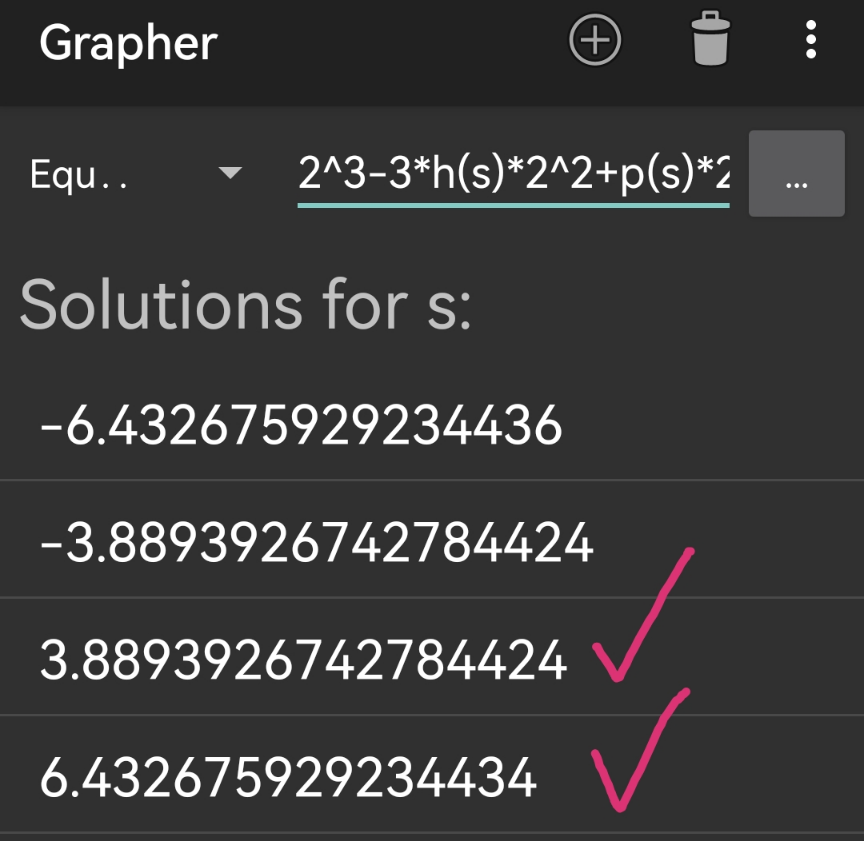
Question Number 199101 by cortano12 last updated on 28/Oct/23
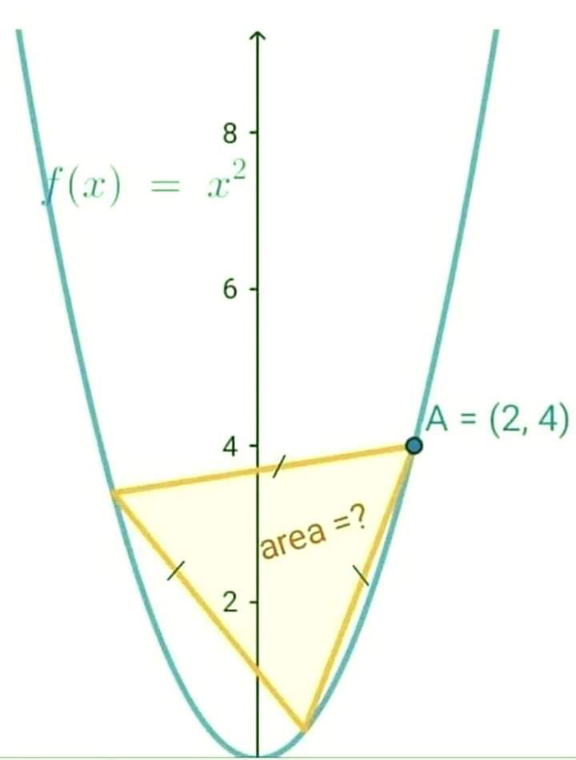
Answered by ajfour last updated on 28/Oct/23
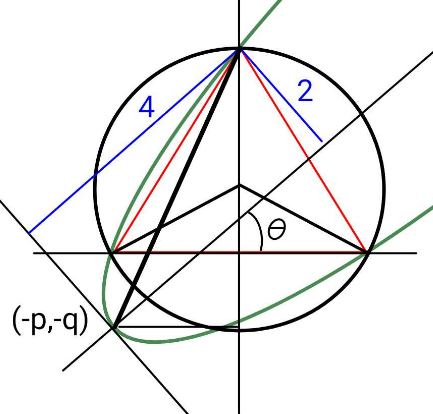
Commented by ajfour last updated on 28/Oct/23
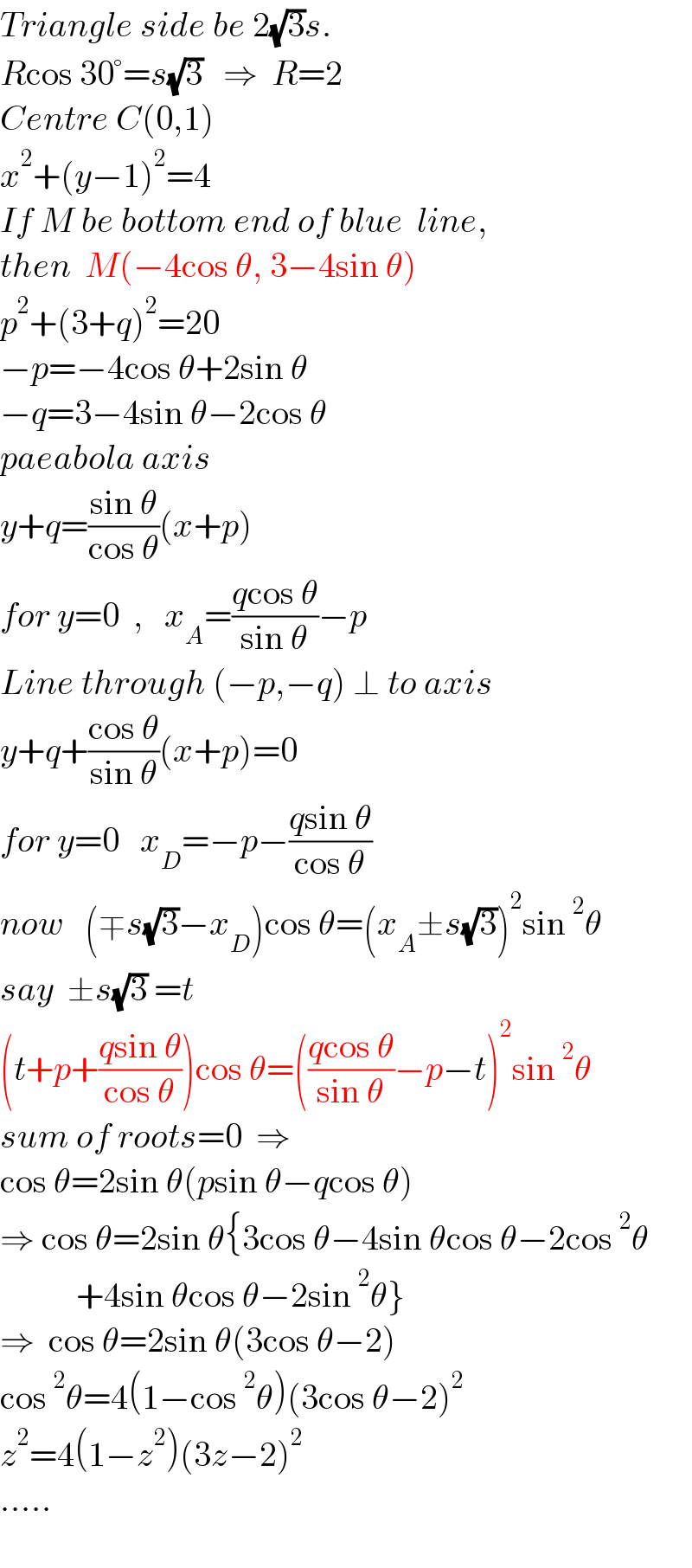
$${Triangle}\:{side}\:{be}\:\mathrm{2}\sqrt{\mathrm{3}}{s}. \\ $$$${R}\mathrm{cos}\:\mathrm{30}°={s}\sqrt{\mathrm{3}}\:\:\:\Rightarrow\:\:{R}=\mathrm{2} \\ $$$${Centre}\:{C}\left(\mathrm{0},\mathrm{1}\right) \\ $$$${x}^{\mathrm{2}} +\left({y}−\mathrm{1}\right)^{\mathrm{2}} =\mathrm{4} \\ $$$${If}\:{M}\:{be}\:{bottom}\:{end}\:{of}\:{blue}\:\:{line}, \\ $$$${then}\:\:{M}\left(−\mathrm{4cos}\:\theta,\:\mathrm{3}−\mathrm{4sin}\:\theta\right) \\ $$$${p}^{\mathrm{2}} +\left(\mathrm{3}+{q}\right)^{\mathrm{2}} =\mathrm{20} \\ $$$$−{p}=−\mathrm{4cos}\:\theta+\mathrm{2sin}\:\theta \\ $$$$−{q}=\mathrm{3}−\mathrm{4sin}\:\theta−\mathrm{2cos}\:\theta \\ $$$${paeabola}\:{axis} \\ $$$${y}+{q}=\frac{\mathrm{sin}\:\theta}{\mathrm{cos}\:\theta}\left({x}+{p}\right) \\ $$$${for}\:{y}=\mathrm{0}\:\:,\:\:\:{x}_{{A}} =\frac{{q}\mathrm{cos}\:\theta}{\mathrm{sin}\:\theta}−{p} \\ $$$${Line}\:{through}\:\left(−{p},−{q}\right)\:\bot\:{to}\:{axis} \\ $$$${y}+{q}+\frac{\mathrm{cos}\:\theta}{\mathrm{sin}\:\theta}\left({x}+{p}\right)=\mathrm{0}\:\:\: \\ $$$${for}\:{y}=\mathrm{0}\:\:\:{x}_{{D}} =−{p}−\frac{{q}\mathrm{sin}\:\theta}{\mathrm{cos}\:\theta} \\ $$$${now}\:\:\:\left(\mp{s}\sqrt{\mathrm{3}}−{x}_{{D}} \right)\mathrm{cos}\:\theta=\left({x}_{{A}} \pm{s}\sqrt{\mathrm{3}}\right)^{\mathrm{2}} \mathrm{sin}\:^{\mathrm{2}} \theta \\ $$$${say}\:\:\pm{s}\sqrt{\mathrm{3}}\:={t} \\ $$$$\left({t}+{p}+\frac{{q}\mathrm{sin}\:\theta}{\mathrm{cos}\:\theta}\right)\mathrm{cos}\:\theta=\left(\frac{{q}\mathrm{cos}\:\theta}{\mathrm{sin}\:\theta}−{p}−{t}\right)^{\mathrm{2}} \mathrm{sin}\:^{\mathrm{2}} \theta \\ $$$${sum}\:{of}\:{roots}=\mathrm{0}\:\:\Rightarrow \\ $$$$\mathrm{cos}\:\theta=\mathrm{2sin}\:\theta\left({p}\mathrm{sin}\:\theta−{q}\mathrm{cos}\:\theta\right) \\ $$$$\Rightarrow\:\mathrm{cos}\:\theta=\mathrm{2sin}\:\theta\left\{\mathrm{3cos}\:\theta−\mathrm{4sin}\:\theta\mathrm{cos}\:\theta−\mathrm{2cos}\:^{\mathrm{2}} \theta\right. \\ $$$$\left.\:\:\:\:\:\:\:\:\:\:\:+\mathrm{4sin}\:\theta\mathrm{cos}\:\theta−\mathrm{2sin}\:^{\mathrm{2}} \theta\right\} \\ $$$$\Rightarrow\:\:\mathrm{cos}\:\theta=\mathrm{2sin}\:\theta\left(\mathrm{3cos}\:\theta−\mathrm{2}\right) \\ $$$$\mathrm{cos}\:^{\mathrm{2}} \theta=\mathrm{4}\left(\mathrm{1}−\mathrm{cos}\:^{\mathrm{2}} \theta\right)\left(\mathrm{3cos}\:\theta−\mathrm{2}\right)^{\mathrm{2}} \\ $$$${z}^{\mathrm{2}} =\mathrm{4}\left(\mathrm{1}−{z}^{\mathrm{2}} \right)\left(\mathrm{3}{z}−\mathrm{2}\right)^{\mathrm{2}} \\ $$$$..... \\ $$$$ \\ $$
Answered by mr W last updated on 28/Oct/23
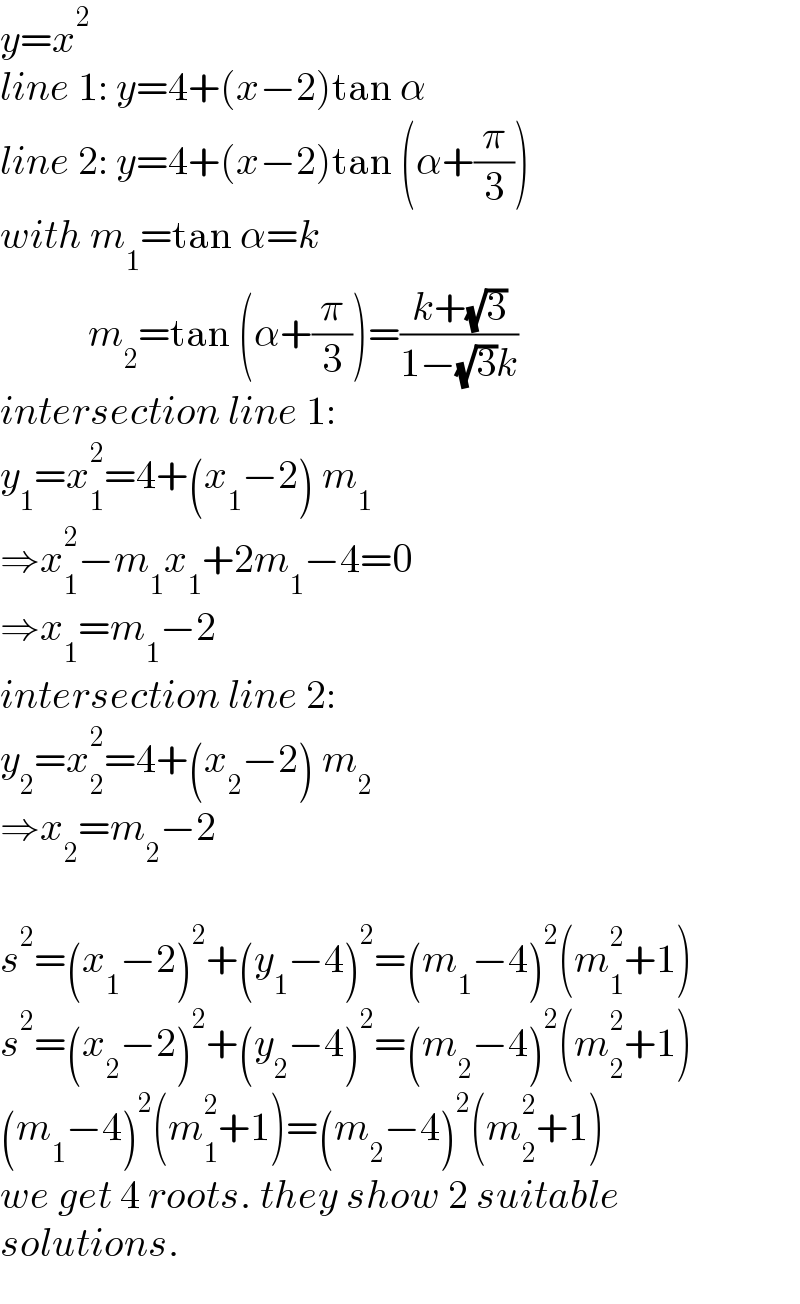
$${y}={x}^{\mathrm{2}} \\ $$$${line}\:\mathrm{1}:\:{y}=\mathrm{4}+\left({x}−\mathrm{2}\right)\mathrm{tan}\:\alpha \\ $$$${line}\:\mathrm{2}:\:{y}=\mathrm{4}+\left({x}−\mathrm{2}\right)\mathrm{tan}\:\left(\alpha+\frac{\pi}{\mathrm{3}}\right) \\ $$$${with}\:{m}_{\mathrm{1}} =\mathrm{tan}\:\alpha={k} \\ $$$$\:\:\:\:\:\:\:\:\:\:\:{m}_{\mathrm{2}} =\mathrm{tan}\:\left(\alpha+\frac{\pi}{\mathrm{3}}\right)=\frac{{k}+\sqrt{\mathrm{3}}}{\mathrm{1}−\sqrt{\mathrm{3}}{k}} \\ $$$${intersection}\:{line}\:\mathrm{1}: \\ $$$${y}_{\mathrm{1}} ={x}_{\mathrm{1}} ^{\mathrm{2}} =\mathrm{4}+\left({x}_{\mathrm{1}} −\mathrm{2}\right)\:{m}_{\mathrm{1}} \\ $$$$\Rightarrow{x}_{\mathrm{1}} ^{\mathrm{2}} −{m}_{\mathrm{1}} {x}_{\mathrm{1}} +\mathrm{2}{m}_{\mathrm{1}} −\mathrm{4}=\mathrm{0} \\ $$$$\Rightarrow{x}_{\mathrm{1}} ={m}_{\mathrm{1}} −\mathrm{2} \\ $$$${intersection}\:{line}\:\mathrm{2}: \\ $$$${y}_{\mathrm{2}} ={x}_{\mathrm{2}} ^{\mathrm{2}} =\mathrm{4}+\left({x}_{\mathrm{2}} −\mathrm{2}\right)\:{m}_{\mathrm{2}} \\ $$$$\Rightarrow{x}_{\mathrm{2}} ={m}_{\mathrm{2}} −\mathrm{2} \\ $$$$ \\ $$$${s}^{\mathrm{2}} =\left({x}_{\mathrm{1}} −\mathrm{2}\right)^{\mathrm{2}} +\left({y}_{\mathrm{1}} −\mathrm{4}\right)^{\mathrm{2}} =\left({m}_{\mathrm{1}} −\mathrm{4}\right)^{\mathrm{2}} \left({m}_{\mathrm{1}} ^{\mathrm{2}} +\mathrm{1}\right) \\ $$$${s}^{\mathrm{2}} =\left({x}_{\mathrm{2}} −\mathrm{2}\right)^{\mathrm{2}} +\left({y}_{\mathrm{2}} −\mathrm{4}\right)^{\mathrm{2}} =\left({m}_{\mathrm{2}} −\mathrm{4}\right)^{\mathrm{2}} \left({m}_{\mathrm{2}} ^{\mathrm{2}} +\mathrm{1}\right) \\ $$$$\left({m}_{\mathrm{1}} −\mathrm{4}\right)^{\mathrm{2}} \left({m}_{\mathrm{1}} ^{\mathrm{2}} +\mathrm{1}\right)=\left({m}_{\mathrm{2}} −\mathrm{4}\right)^{\mathrm{2}} \left({m}_{\mathrm{2}} ^{\mathrm{2}} +\mathrm{1}\right) \\ $$$${we}\:{get}\:\mathrm{4}\:{roots}.\:{they}\:{show}\:\mathrm{2}\:{suitable}\: \\ $$$${solutions}. \\ $$
Commented by mr W last updated on 28/Oct/23
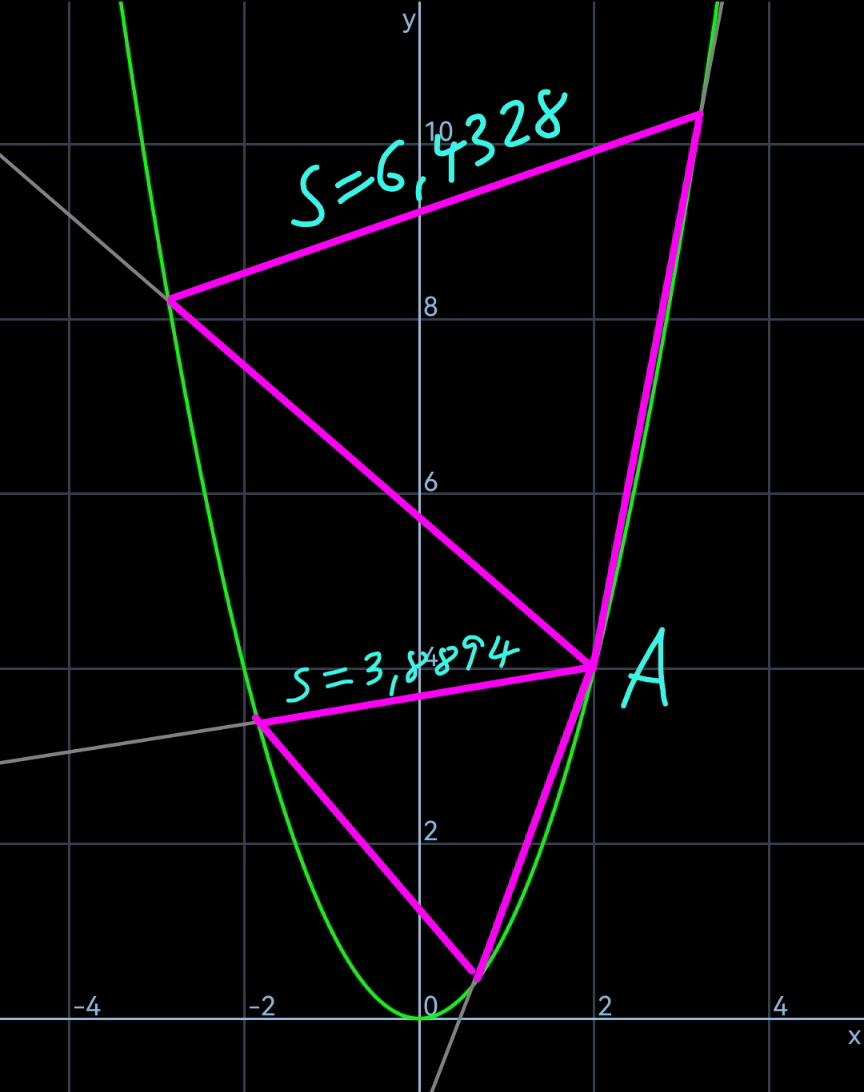
Commented by cortano12 last updated on 28/Oct/23

$$\mathrm{great}\:\mathrm{sir} \\ $$
Answered by mr W last updated on 28/Oct/23
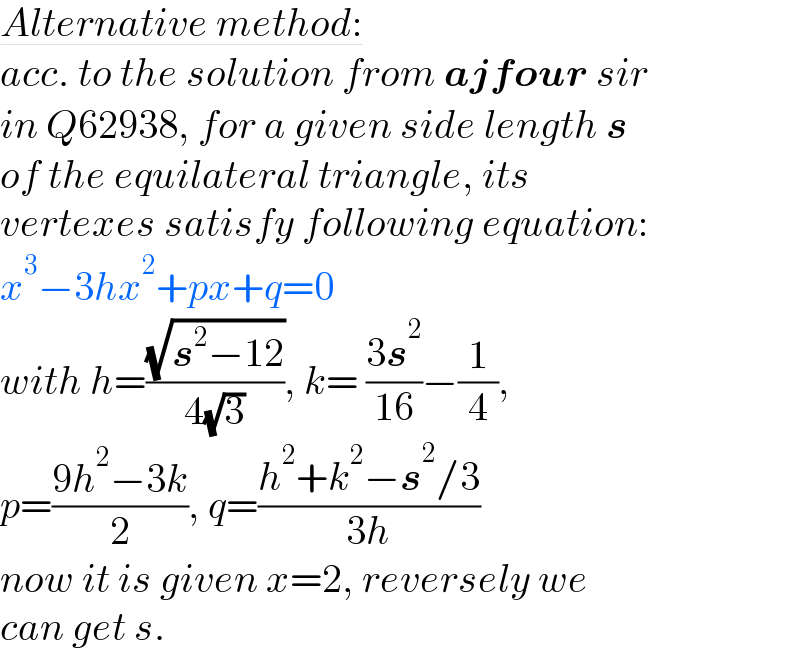
$$\underline{{Alternative}\:{method}:} \\ $$$${acc}.\:{to}\:{the}\:{solution}\:{from}\:\boldsymbol{{ajfour}}\:{sir} \\ $$$${in}\:{Q}\mathrm{62938},\:{for}\:{a}\:{given}\:{side}\:{length}\:\boldsymbol{{s}}\: \\ $$$${of}\:{the}\:{equilateral}\:{triangle},\:{its}\: \\ $$$${vertexes}\:{satisfy}\:{following}\:{equation}: \\ $$$${x}^{\mathrm{3}} −\mathrm{3}{hx}^{\mathrm{2}} +{px}+{q}=\mathrm{0}\: \\ $$$${with}\:{h}=\frac{\sqrt{\boldsymbol{{s}}^{\mathrm{2}} −\mathrm{12}}}{\mathrm{4}\sqrt{\mathrm{3}}},\:{k}=\:\frac{\mathrm{3}\boldsymbol{{s}}^{\mathrm{2}} }{\mathrm{16}}−\frac{\mathrm{1}}{\mathrm{4}}, \\ $$$${p}=\frac{\mathrm{9}{h}^{\mathrm{2}} −\mathrm{3}{k}}{\mathrm{2}},\:{q}=\frac{{h}^{\mathrm{2}} +{k}^{\mathrm{2}} −\boldsymbol{{s}}^{\mathrm{2}} /\mathrm{3}}{\mathrm{3}{h}} \\ $$$${now}\:{it}\:{is}\:{given}\:{x}=\mathrm{2},\:{reversely}\:{we} \\ $$$${can}\:{get}\:{s}. \\ $$
Commented by mr W last updated on 28/Oct/23
